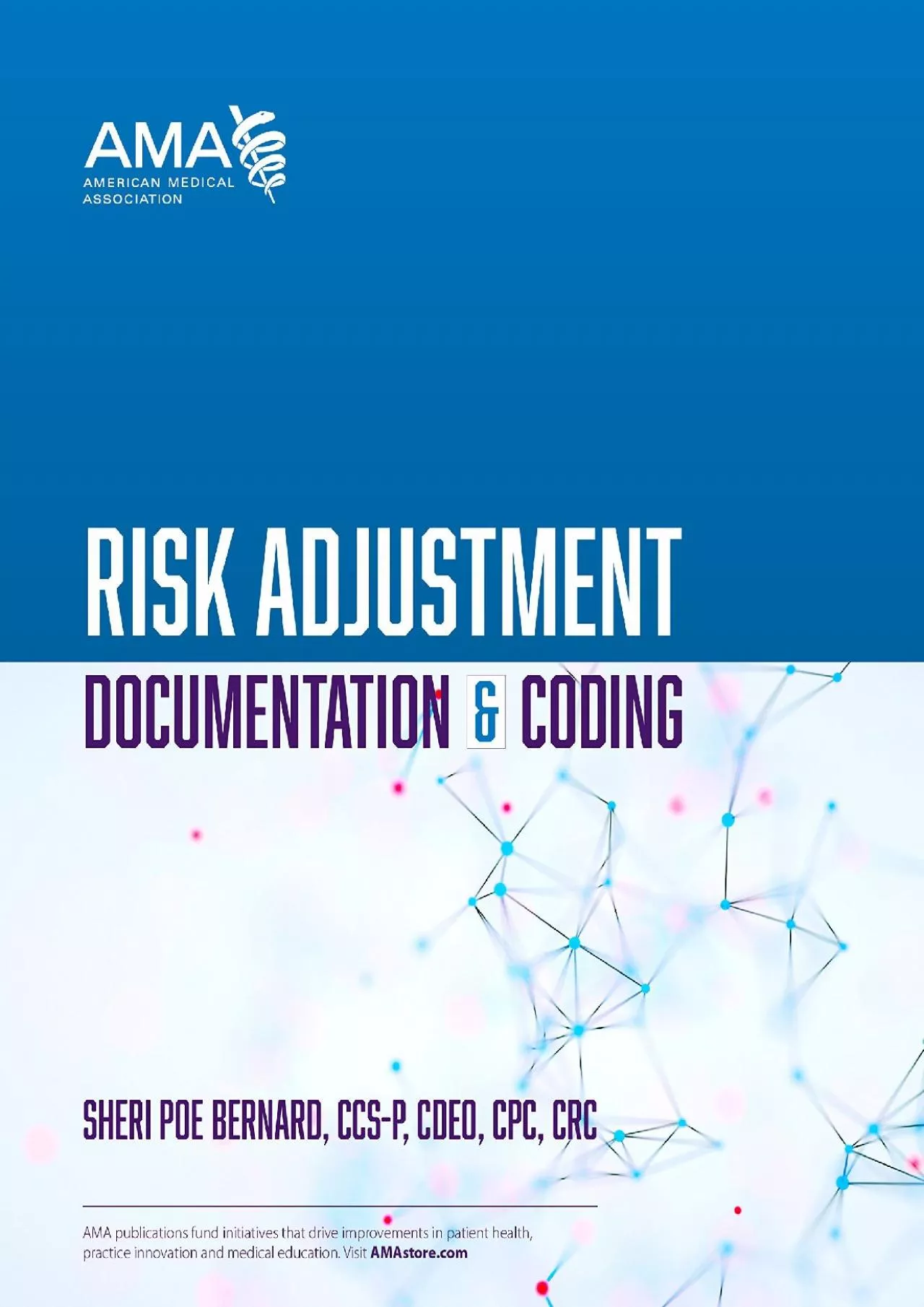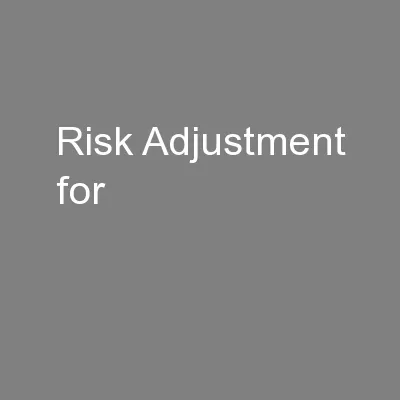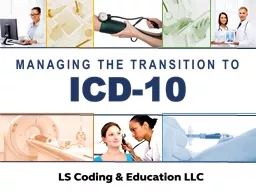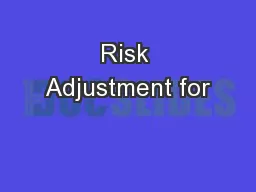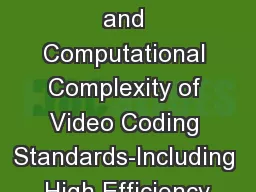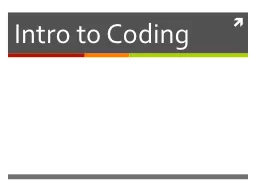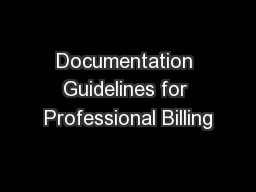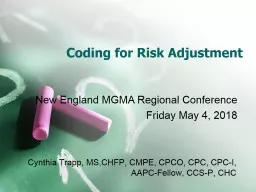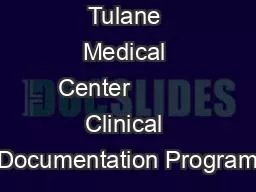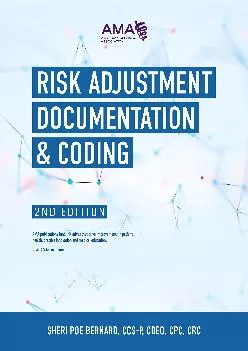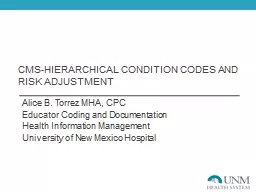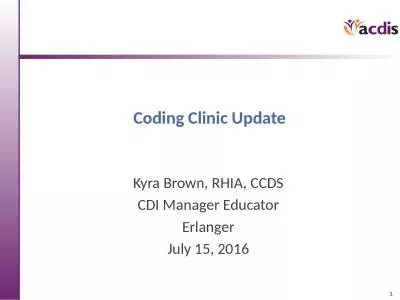PDF-(EBOOK)-Risk Adjustment Documentation & Coding
Author : loraleebankes | Published Date : 2022-06-23
Riskadjustment practices consider chronic diseases as predictors of future healthcare needs and expenses Detailed documentation and compliant diagnosis coding are
Presentation Embed Code
Download Presentation
Download Presentation The PPT/PDF document "(EBOOK)-Risk Adjustment Documentation & ..." is the property of its rightful owner. Permission is granted to download and print the materials on this website for personal, non-commercial use only, and to display it on your personal computer provided you do not modify the materials and that you retain all copyright notices contained in the materials. By downloading content from our website, you accept the terms of this agreement.
(EBOOK)-Risk Adjustment Documentation & Coding: Transcript
Riskadjustment practices consider chronic diseases as predictors of future healthcare needs and expenses Detailed documentation and compliant diagnosis coding are critical for proper risk adjustmentRisk Adjustment Documentation Coding provides Risk adjustment parameters to improve documentation related to severity of illness and chronic diseases Code abstraction designed to improve diagnostic coding accuracy without causing financial harm to the practice or health facility The impact of risk adjustment codingalso called hierarchical condition category HCC codingon a practice should not be underestimated More than 75 million Americans are enrolled in riskadjusted insurance plans This population represents more than 20 of those insured in the United States Insurance risk pools under the Affordable Care Act include risk adjustment CMS has proposed expanding audits on risk adjustment coding Meticulous diagnostic documentation and coding is key to accurate riskadjustment reporting This book will help align the industry though an objective compilation and presentation of risk adjustment documentation and coding issues guidance and federal resourcesFeatures and Benefits Five chapters delivering an overview of risk adjustment common administrative errors best practices topical review of clinical documentation improvement and coding for risk adjustment alphabetized by HCC group and guidance for development of internal risk adjustment coding policies Six appendices offering mappings tabular information and training tools for coders and physicians that include an alphanumeric mapping of ICD10CM codes to HCCs and RxHCCs and information about Health and Human Services HCCs versus Medicare Advantage HCCs Learning and design features Vocabulary terms highlighted within the text and conveniently defined at the bottom of the page AdviceAlert Notes that highlight important advice from the ICD10CM Guidelines for Coding and Reporting Key Coding Concepts that offer the advice published in ICD10CM Coding Clinic for ICD10CM and ICD10PCS Sidebars that detail measurements pertinent to risk adjustment seen in physician documentation eg cancer staging disability status or GFRs Coding Tips that guide coders to the right answers using terminology and ICD10CM Index and Tabular entries or provide cautionary notes about conflicts in the official ICD10CM guidance Clinical Examples that underscore key documentation issues for risk adjustment Clinical coding examples that provide snippets or full encounter notes and codes to illustrate key issues for the HCC or RxHCC Documentation tips highlight recommendations to physicians regarding what should be included in the medical record or how ICD10CM may classify specific terms Examples that explain difficult concepts and promote understanding of those concepts as they relate to a section FYI call outs that provide quick facts Extensive endofchapter Evaluate Your Understanding sections that include multiplechoice questions trueorfalse questions and Internetbased exercises Downloadable slide presentations for each chapter that cover key content and concepts Exclusive content for academic educators A test bank containing 100 questions and a mock riskadjustment certification exam with 150 questions. g gym memberships and exercise classes Medicare Advantage plan receives payment for each member from CMS Payment is based on member predicted health status and demographic characteristics Medicare Advantage plan regulated by CMS brPage 6br Introducti Socioeconomic Status;. Linking Cost and Quality Measures. HSCRC . Performance Measurement . Workgroup. May 28, 2014 . Tom Valuck, MD, JD. Presentation. . Overview. U. pdate . the . Performance Measurement Workgroup . ICD-10 is set to go into effect on October 1st, 2015. Once it does, some of the changes that will go into effect include:. Increasing the number of diagnosis codes from around 13,000 to around 68,000, and the number of procedure codes from 11,000 to 72,000.. Socioeconomic Status;. Linking Cost and Quality Measures. HSCRC . Performance Measurement . Workgroup. May 28, 2014 . Tom Valuck, MD, JD. Presentation. . Overview. U. pdate . the . Performance Measurement Workgroup . Zarna. Patel. 1001015672. z. arnaben.patel@mavs.uta.edu. . Objective. The primary goal of most digital video coding standards has been to optimize coding efficiency. . The . objective of this project is to analyze the coding efficiency and computational complexity that can be achieved by use of the emerging High Efficiency Video Coding (HEVC) standard, relative to the coding efficiency characteristics of its major predecessors including, H.263 [29], and H.264/MPEG-4 Advanced Video Coding (AVC) [14]. . Coding is what is used to create computer software, apps, and websites.. Examples:. Your operating system (OS). Apps on your phone. Facebook, . Snapchat. , . Instagram. Benefits of Coding. It empowers you to do many things you wouldn’t otherwise be able to do.. KMSF Documentation/Coding Education Department and Revenue Cycle - Professional Coding. Objectives. Identify the differences between professional (physician) billing and hospital (facility) billing. Identify the overarching criteria for documenting Evaluation and Management (E/M) services. rhit. Mary Girard, . ba. , ma, . rhit. , ccs-p. Jamey . mcgowen,. . mba. , . rhia. Agenda . Lcd. /. ncd. edits. Staff morale. Computer assisted coding . Simple visit coding. Productivity/. Monitoring remote . Cynthia Trapp, MS,CHFP, CMPE, CPCO, CPC, CPC-I, AAPC-Fellow, CCS-P, CHC. New England MGMA Regional Conference. Friday May 4, 2018. Defining Risk Adjustment. History of CMS Risk Adjustment. Risk Adjustment Models. Hospitalist . Presentation . 10/18/10. What is CDI?. BRIDGING THE GAP . Between what CMS (Center for Medicare & Medicaid Services) recognizes (technical terminology of the ICD-9 system) and the clinical language physicians use to describe the patient’s condition. Capturing risk in medical documentation and coding successfully gives a complete and accurate picture of your patients’ health but it is also critical for ensuring proper reimbursement, managing cost, projecting future resource requirements and delivering high-quality care. Chronic diseases are not outliers, especially in older patients. 80% percent of older adults have at least one chronic condition. If you have any Medicare patients with chronic conditions and if you are participating in Merit-based Incentive Payment Systems (MIPS), the AMA’s Risk Adjustment, Documentation and Coding 2e (RA, 2e) will help you capture the care rendered so the severity of your patients’ illnesses is adequately captured to reflect your utilization. If you omit risk-adjusting diagnoses because a specialist is managing the care of your patient’s chronic condition, you are hurting your MIPS efficiency rating. Most chronic conditions will impact the overall health of the patient therefore, they are appropriate to capture for your documentation.In a value and outcome-based health care environment, lack of specificity in ICD-10-CM coding and documentation has ripple effects for a practice and its patients, like – loss of important data and financial returns and increased patient risk. Continuity of care and a complete picture of a patient’s overall health are key to quality care. Connecting diagnosis with comorbidities (causes) with ICD-10-CM codes (such as hypertension with heart disease or diabetes and hyperlipidemia with diabetes, etc.) for patients with chronic conditions helps improve care and documentation. RA, 2e, covers this in detail and can help you document your patient’s health and wellbeing, and help you get the right reimbursement, especially for your high-risk patients. Use Risk Adjustment Documentation & Coding, 2nd Edition, to: Improve documentation in general and in relation to severity of illness and chronic diseases with risk adjustment parameters. Code more accurately with expert guidelines and recommendations.Connect diagnosis with comorbidities (cause) with the checklists in the teaching/training tools for the 10 most common chronic diseases.The impact of risk-adjustment coding (hierarchical condition category (HCC) coding) on a practice is significant because: More than 75 million Americans are enrolled in risk-adjusted insurance plans. This population represents more than 20% of those insured in the United States. Insurance risk pools under the Affordable Care Act include risk adjustment. CMS, which disbursed more than $900 million in MIPS bonuses for 2020, is tightening requirements for these bonuses, and has also proposed expanding audits on risk-adjustment coding.FEATURES AND BENEFITSFive chapters delivering an overview of risk adjustment, common administrative errors, best practices and guidance for development of internal risk-adjustment coding policies, which are organized by diagnoses topic (diabetes, dementia, ischemic heart, etc). Each topic has separate guidance for documentation and for coding.10 ICD-10-CM teaching/training tools for the top-10 most-common chronic diseases to help with documentation and coding.10 ICD-10-CM coding aid for quick reference and code selection for the top-10 most-common chronic diseases. Two appendices offering mappings and tabular information of ICD-10-CM codes that risk-adjust to CMS-HCCs (used for MIPS) and RxHCCs. Learning and design features: Vocabulary terms highlighted within the text and defined at the bottom of the page. Advice/Alert Notes?that highlight important coding and documentation advice from federal regulatory sources. Sidebars?that provide derivative story and additional information, such as: Coding Tips?that guide physicians and coders with practical advice from sources like AHA\'s Coding Clinic and cautionary notes about conflicts and exceptions.Clinical Examples?that underscore key documentation issues for risk adjustment. Clinical Coding Examples?that provide snippets or full encounter notes and codes to illustrate risk-adjustment coding and documentation concepts. Documentation tips?that highlight recommendations to physicians regarding what should be included in the medical record or how ICD-10-CM may classify specific terms. Examples?that explain difficult concepts and promote understanding of those concepts as they relate to a section FYI?call outs that provide quick facts. Abstract & Code It!?exercises that test diagnosis abstraction and coding skills (exclusive to Chapter 4). Assessment tools for instructors and independent learners:Extensive end-of-chapter Evaluate Your Understanding sections that include multiple-choice questions, true-or false questions, and audit- and Internet-based exercises. Two downloadable course tests and slide presentations for each chapter. Exclusive content for academic educators: A test bank containing 100 questions and a mock risk-adjustment certification exam with 150 questions. Alice B. Torrez MHA, CPC. Educator Coding and Documentation. Health Information Management. University of New Mexico Hospital. 2. View of Risk Adjustment. Are my patients . sicker?. These numbers are not right…. kindly visit us at www.examsdump.com. Prepare your certification exams with real time Certification Questions & Answers verified by experienced professionals! We make your certification journey easier as we provide you learning materials to help you to pass your exams from the first try. Professionally researched by Certified Trainers,our preparation materials contribute to industryshighest-99.6% pass rate among our customers. CDI Manager Educator. Erlanger. July 15, 2016. Learning Objectives. At the completion of this educational activity, the learner will be able to:. Provide an overview on structure of ICD-10-CM/PCS coding conventions, guidelines, and official advice essential to understanding Coding Clinic advice.
Download Rules Of Document
"(EBOOK)-Risk Adjustment Documentation & Coding"The content belongs to its owner. You may download and print it for personal use, without modification, and keep all copyright notices. By downloading, you agree to these terms.
Related Documents

